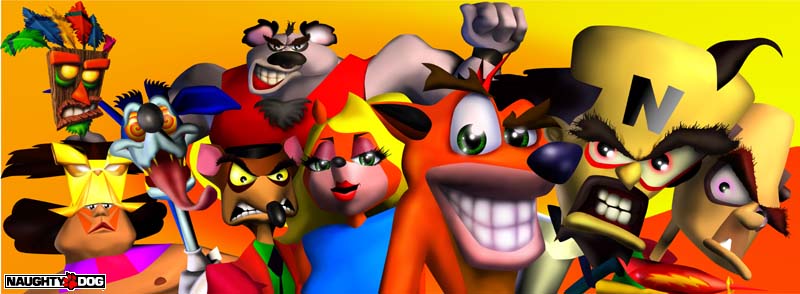Naughty Dog’s Crash Bandicoot gave the PlayStation its first mascot and uniquely transformed the genre of platformers into a 3-D space. After accepting a deal with Universal Interactive Studios, Naughty Dog co-founders Andy Gavin and Jason Rubin moved across the country to California to work in Universal’s lot next to Steven Spielberg. With the backing of Universal, Naughty Dog was able to obtain five Silicon Graphics workstations for about $75,000-100,000 each for the purpose of developing 3-D graphics. With the belief that Sony’s console would be the best platform to develop in 3-D space and the hope to create Sony’s mascot, Naughty Dog developed their new game around a prototype PlayStation. The desire to create a mascot for Sony can be observed by the level of detail in the main character Crash. Relative to other games’ protagonists at the time Crash was much less pixelated and blocklike. This was a result of the computing power that was partitioned to render Crash. In each frame, the PlayStation was able to render 1,500 polygons and 600 of them were dedicated to Crash. This meant that over a third of the entire budget of polygons went to rendering Crash.1 To this day, Sony still does not have a definitive mascot, but Crash Bandicoot arguably succeeded at becoming the first PlayStation’s mascot when the game was released in 1996. The first three Crash Bandicoot games were the 11th, 7th, and 8th best-selling PlayStation games respectively. Additionally, out of all the top ten best-selling PlayStation games, the games from the Crash Bandicoot franchise were the only games to have their protagonist’s name in the name of the videogame aside from Harry Potter in Harry Potter and the Philosopher’s Stone.2
Of course, Naughty Dog’s attention to detail for their main character would not have mattered if their gameplay was not up to par. The goal of Crash Bandicoot is to navigate through 32 levels as Crash in order to prevent Doctor Neo Cortex, the mad scientist who created Crash, from achieving world domination and to save Tawna, another bandicoot genetically enhanced by Doctor Neo Cortex. Crash can spin to attack enemies and break certain obstacles, collect 100 Wumpa Fruit to gain extra lives, and collect Aku Aku masks that protect against a single hit. Collecting three masks gives Crash invulnerability for a short period of time. The controls are relatively simple, using the D-pad to move Crash in eight possible directions, pressing X to jump, pressing triangle to display a player’s inventory, and pressing square or circle to perform a spin attack. The most challenging mechanic of Crash Bandicoot is what a player has to accomplish to merely save the game. There are two ways a player can save their game. Firstly, a player can complete an entire level without dying a single time and destroy all boxes to obtain a gem. Secondly, a player can obtain all bonus tokens in a level to play a bonus level and then complete the bonus level without losing a single life. This harsh mechanic adds to the intensity of the gameplay by making players worry about dying even when they have multiple lives; however, it definitely increases the barrier to entry as well.
Although the gameplay mechanics of Crash Bandicoot did not do anything particularly revolutionary, its use of 3-D graphics sets it apart from other platformers at the time. Crash Bandicoot was notably not the only platformer to make the transition to a 3-D space in 1996. Super Mario 64 came out in the same year on the Nintendo 64 and saw even greater commercial success than Crash Bandicoot, but the games were developed independently from each other which can be seen in their unique differences. Super Mario 64 took a more open-world approach, not limiting as many dimensions as Crash Bandicoot and allowing players to control the third-person camera which had a wider field of view. The philosophy behind many levels of Crash Bandicoot was that the transition from 2-D to 3-D had added a dimension, so the developers could now take out other dimensions. For example, in one level, a boulder is rolling down a hill behind Crash, and the player sees Crash from a third-person point of view that is in front of Crash. In this level, the dimension that is removed is time, because a player is no longer able to explore all parts of the 3-D space or they will be flattened by the boulder. Another example of removing the dimension of time is a level where Crash rides on a hog. The player sees Crash from behind in this level and cannot stop moving forward because the hog never stops running. Naughty Dog also incorporated what were essentially 2-D levels with 3-D aspects. The levels would have a fixed camera to the side of Crash, similar to traditional 2-D platformers. However, the game would take advantage of the 3-D graphics by having certain sections of the levels where Crash could walk away from the camera into spaces cut into the walls.3 One might think having limited dimensions made Crash Bandicoot a worse game than Super Mario 64, but this constraint added to the fast pace intensity of the game and meant the camera is always along a fixed path allowing the game to have a greater level of detail both in map designs and character expressions. Ultimately, Crash Bandicoot presented a unique take on platformers using new 3-D technology and as a result, Sony had an unexpected Looney Tunes-style Australian animal as its first gaming console’s mascot.
References:
1 How Crash Bandicoot Hacked The Original Playstation | War Stories | Ars Technica
2 https://en.wikipedia.org/wiki/List_of_best-selling_PlayStation_video_games
3 How Crash Bandicoot Hacked The Original Playstation | War Stories | Ars Technica

